
* From the late 1940s, De Havilland Canada (DHC) established a reputation with its single-engine "DHC-2 Beaver" and larger "DHC-3 Otter" utility aircraft as a manufacturer of rugged "bushplanes" with very good "short takeoff & landing (STOL)" performance. In the late 1950s, DHC went on to build a larger twin-engine STOL cargolifter, the "DHC-4 Caribou", which saw extensive combat service in Vietnam. It was followed by the "DHC-5 Buffalo", which was much the same aircraft except for fit of turboprop instead of piston engines. This document provides a history and description of the Caribou and Buffalo. A list of illustration credits is included at the end.
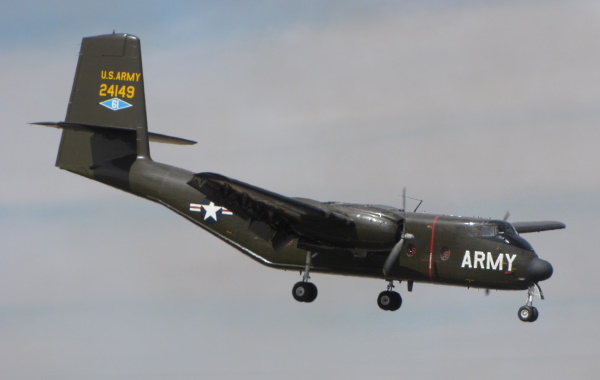
* In 1954, with US Army encouragement, de Havilland Canada decided to build a STOL transport in the size range of the Douglas DC-3 / C-47. The effort was primed by an initial order for two prototypes from the Canadian government and an order for five evaluation aircraft from the US Army, with the US Army obtaining a waiver to permit their acquisition -- it was a bigger aircraft than the service's pact with the US Air Force permitted the Army to have. Small aerodynamic models of the "DHC-4 Caribou", as it was named, were evaluated first on a truck, then on the back of a DHC-3 Otter. The first Caribou performed its initial flight on 30 July 1958.
Following US Army evaluation of the five "YAC-1" machines -- one of which crashed in 1959, to be replaced by a sixth YAC-1 -- the Army placed an initial order for what would amount to a total of 56 "AC-1" production aircraft, with all deliveries in 1961. The AC-1 and was redesignated "CV-2B" in 1962, when the US armed services adopted a common designation scheme.
Further orders followed, with deliveries from 1963. These machines were in the form of the "DHC-4A" AKA "CV-2B" variant -- originally the US Army designation was supposed to be "AC-1A" -- similar to the DHC-4, except for structural reinforcements to support higher maximum takeoff weight. Later production also had an AN/APB-158 weather radar in a nose pimple, with the radar fitted to earlier AC-1As and some AC-1s. A total of 103 AC-1A Caribous was built.
The US Army obtained a total of 6 + 56 + 103 = 165 Caribous. The last Caribous were rolled out in 1973 after the production of 307 machines, with the US Army being by far the biggest single operator, obtaining the majority of DHC-4s built.
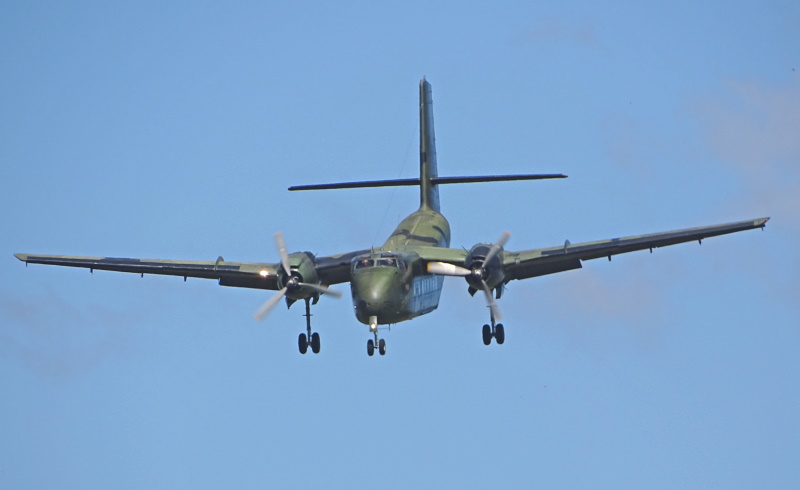
* The Caribou was a straightforward medium tactical cargolifter, with twin piston engines; a high wing; an oversized tailfin, with the tailplane mounted well above the fuselage; and a high tail with loading doors. The wing had an inverted gull configuration; they featured full-span double-slotted flaps for short takeoff performance, the outer flap sections doubling as ailerons.
The DHC-4 was powered by PW R-2000-7M2 air-cooled two-row 14-cylinder Twin Wasp radials providing 1,080 kW (1,450 HP) each, driving three-blade variable-pitch propellers. Most Caribous were delivered with prop spinners, though they were generally deleted later, being judged more trouble than they were worth. Some Caribous were fitted with reversible propellers in service to improve short-field landing capability. The engine cowling opened up in triple "petals", hinged on the rear, for service access.
All landing gear assemblies had twin wheels, the main gear retracting forward into the engine nacelles, the nose gear retracting backward. Production aircraft had a slight fuselage stretch forward of the wing relative to the prototypes; a modified wing, with a fence outboard of the engine on each wing and lift-enhancement devices; and other tweaky changes.
___________________________________________________________________
DE HAVILLAND CANADA DHC-4A CARIBOU:
___________________________________________________________________
wingspan:
29.15 meters (95 feet 8 inches)
wing area:
84.7 sq_meters (912 sq_feet)
length:
22.12 meters (72 feet 8 inches)
height:
9.68 meters (31 feet 9 inches)
empty weight:
8,285 kilograms (18,260 pounds)
MTO weight:
12,925 kilograms (28,500 pounds)
max payload weight:
3,965 kilograms (8,740 pounds)
max speed at altitude:
350 KPH (215 MPH / 185 KT)
service ceiling:
7,560 meters (24,800 feet)
range, max payload:
390 kilometers (240 MI / 210 NMI)
___________________________________________________________________
All fuel storage was in wing tanks outboard of the engines; total fuel load was 3,138 liters (828 US gallons). The US Army developed fuel bladders, in the form of rubber cylinders that looked like very fat tires, that could stow 1,326 liters (350 US gallons) each. Up to three could be hauled in the cargo bay, primarily to increase range for ferry flights, but also potentially for delivery of fuel to forward areas. There was also an experiment with using the Caribou as an inflight refueling tanker, but it was never done operationally.
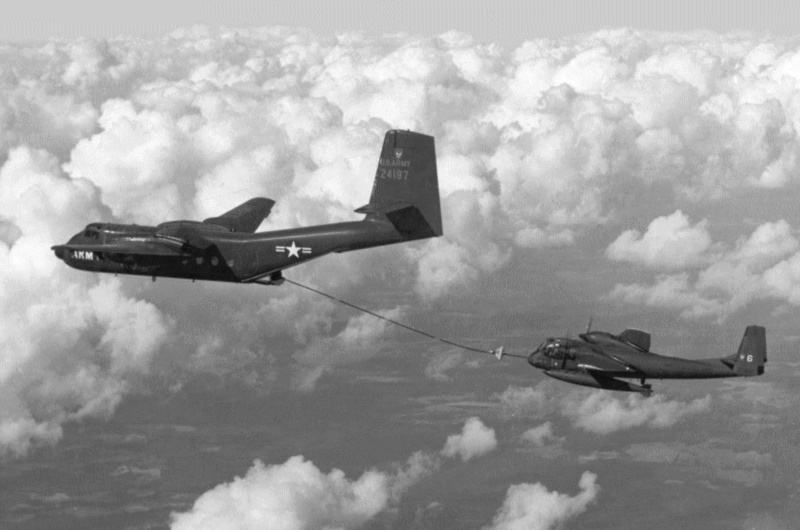
The top tail loading door opened inward and upward, while the bottom tail door opened downward; the tail door could be used as a ground loading ramp in the full down position, and could be fitted with ramp extensions to allow light vehicles to drive up into the cargo bay. The ramp could also be opened to a flat position for airborne paradrops.
There were trapezoidal crew doors on both sides of the rear fuselage; in early production, the crew doors opened forward and had a separate ladder, while in later production they were built as fold-down "airstairs". The right-side door could be jettisoned for passenger escape. There was an access hatch above the cockpit, an escape hatch beneath the cockpit, and another escape hatch behind the cockpit. Payload capacity was 32 troops; or 26 paratroops; or 22 litters, four seated casualties, and four medical attendants; or 3,965 kilograms (8,740 pounds) of cargo, with the cargo bay capable of stowing two jeeps.
BACK_TO_TOP* US Army Caribous were in Vietnam from 1961, generally flying in overall olive drab colors. The Army appreciated the STOL performance of the Caribou; the Air Force preferred the Fairchild C-123 Provider, which had twice the payload, but limited STOL capability. Caribous were seen as particularly useful for resupply of remote bases, which were often sited in rugged terrain.
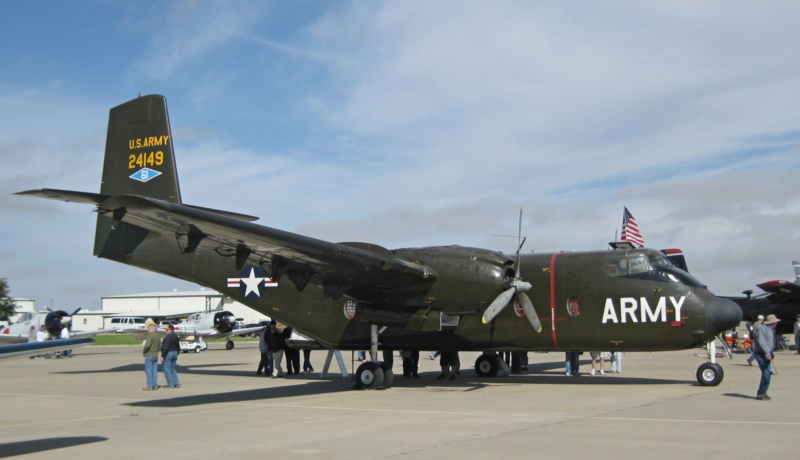
When Caribous couldn't actually land, they used a spectacular technique known originally as "Low Level Extraction (LOLEX)" and later "Low Altitude Parachute Extraction System (LAPES)" -- in which a cargo mounted on a shock-absorbing pallet was yanked out of the aircraft by a drogue parachute as the aircraft flew over the target area at head height. LAPES could only be used for rugged payloads, but it was much more accurate than a parachute drop. Caribous would also sometimes land on bases under fire, keeping their engines revved up, so they could depart the instant a cargo was unloaded. They sometimes didn't make it; there's even a horrific photo capturing the death of a Caribou, being hit by "friendly" artillery fire during its approach to an airfield.
Most of the surviving US Army Caribous were passed on to the US Air Force in early 1967 as the "C-7" and "C-7A", with the Army retaining 15 machines for various duties. The Air Force Caribous, generally repainted in disruptive camouflage colors, continued in heavy use, a few being configured with radio relay gear to operate as battlefield communications relays. As American forces were withdrawn from Vietnam from 1971, the Air Force passed on most of the fleet to the South Vietnamese Air Force, though 32 were flown back to the USA for use with by Air Force Reserve and the US Air National Guard. The South Vietnamese weren't able to maintain their heavily-used Caribous, and the fleet ended up increasingly grounded. Some were still flying when South Vietnam fell to the Communists in 1975, and were used for a time by the new unified Vietnamese state.
Roughly 20 US Caribous were lost in Vietnam. The US Army kept a few Caribous flying into the 1980s; one of the original evaluation machines was used as a jump aircraft and support aircraft for the Army "Golden Knights" parachute demonstration team, with the Caribou painted in spiffy colors.
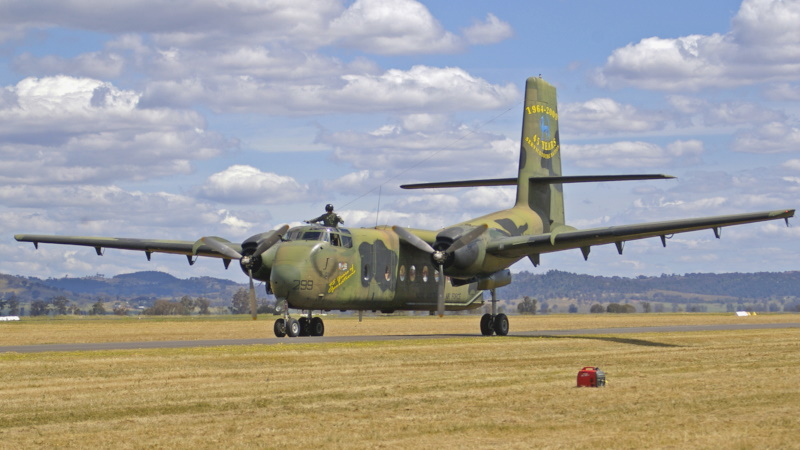
* Other operators flying the Caribou in numbers included:
Other users included:
There was a fair amount of horse trading of machines retired from one service to be obtained by another -- as mentioned above, Spain acquired ex-US Caribous, while Tanzania inherited what was left of the Canadian fleet -- though the details are confusing to track.
Caribous were obtained new by a number of commercial organizations, though not all were really what they seemed. Two were purchased by Air America, a "civilian" front company operated by the US Central Intelligence Agency (CIA), and three were obtained by "Air Asia" -- a Taiwan-based airline, now a commercial organization, but in the 1960s associated with the CIA. Some of the other "civilian" buyers were associated with Air America, which also obtained a fair number of US military Caribous on loan.

About a half dozen DHC-4s were bought new by truly commercial firms, however, and after their service careers, DHC-4s often had second careers in civilian hands. Indeed, they are still flying in a lingering fashion now. Pen Turbo of Cape May, New Jersey, performed a conversion of stock DHC-4s with Pratt & Whitney Canada PT6A turboprops replacing the Twin Wasp radials, the expectation being that there might be a market for "DHC-4T" upgrades. There were at least two conversions, one being lost in a fatal crash in 1992 -- the ghastly incident being captured on video -- and a second conversion following.
What happened after that is unclear, but in 2013 videos appeared online showing a DHC-4T performing supply airdrops to US forces in Afghanistan. The operator was given as the FlightWorks company, working under a contract to the military. It appears that FlightWorks obtained the second DHC-4T conversion.
BACK_TO_TOP* The Caribou went out of production because it was replaced by the "DHC-5 Buffalo", a stretched and turboprop-powered derivative of the Caribou -- in fact, it was originally known as the "Caribou II", with the original Caribou prototype fitted with turboprops as a prototype, performing its initial flight on 22 September 1961. Development was funded by a collaboration of the US Army and the Canadian government, with DHC also contributing funding.
Four evaluation machines were ordered by the US Army, with the first taking to the air on 9 April 1964. Although the Army initially wanted to give the Buffalo the designation of "YAC-2", by the time the service got its hands on the machines, the 1962 redesignation effort had taken place, and so they were known by the designation of "CV-7A".
The Buffalo looked generally like the Caribou, except for the turboprop powerplants; a tee tail; a reprofiled wing with slightly greater span; and a fuselage stretch of about 10%. The DHC-5 was powered by General Electric (GE) T64-GE-10 turboprops providing 2,135 ekW (2,850 EHP). Payload was 41 troops; 35 paratroops; 24 litters and six seated casualties or attendants; or 4,820 kilograms (10,630 pounds) of cargo.
The US Army evaluated the Buffalo in Vietnam, but there were no further US orders. The Buffalos were passed on to the Air Force in 1967 along with the Caribous, with the Air Force designating the Caribous "C-8A". They were used mostly in test and trials by other US government agencies -- see below. Apparently political pressure to "buy American", and USAF disinterest in the type, played roles in not following up the initial evaluation buy.
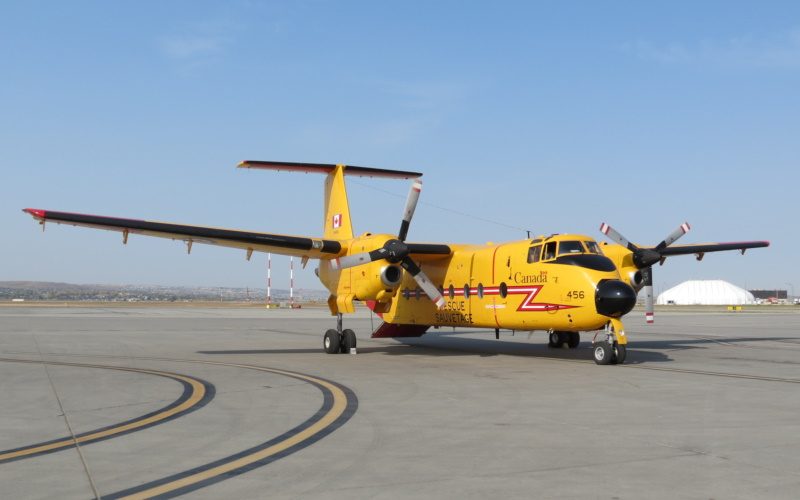
The RCAF obtained 15 DHC-5A machines, which were given the service designation of "CC-115"; they featured CT64-810-1 turboprops with 2,280 ekW (3,055 EHP) and payload increased to 6,280 kilograms (13,845 pounds). At least part of the Canadian fleet was modified to a cargo / search and rescue (SAR) configuration -- it's not exactly clear what the SAR conversion entailed, the SAR machines only being visibly different in having bulged observation windows on the rear crew doors.
One of the Canadian Buffalos, operating in UN colors, was shot down by a Syrian surface-to-air missile over Lebanon in 1974, killing all nine on board. At last report, the CC-115s were still in service, though in 2016 the Airbus C295W was selected as a replacement, with deliveries to be from 2019 into 2022.
___________________________________________________________________
DE HAVILLAND CANADA DHC-5A BUFFALO:
___________________________________________________________________
wingspan:
29.26 meters (96 feet)
wing area:
87.8 sq_meters (912 sq_feet)
length:
24.08 meters (79 feet)
height:
8.73 meters (28 feet 8 inches)
empty weight:
10,505 kilograms (23,155 pounds)
MTO weight:
18,600 kilograms (41,000 pounds)
max payload weight:
4,820 kilograms (10,630 pounds)
max speed at altitude:
435 KPH (270 MPH / 235 KT)
service ceiling:
9,150 meters (30,000 feet)
range, max payload:
815 kilometers (510 MI / 440 NMI)
The original C-8A machines had no radar and so were shorter.
___________________________________________________________________
24 more DHC-5s were built for Brazil, serving until retirement in 2008, and then 16 for Peru, with production halted in 1972. However, there was still demand for the Buffalo, and so DHC restarted production in 1974, rolling out the "DHC-5D", with CT64-820-4 turboprops providing 2,335 ekW (3,130 EHP) and cargo load raised to 8,165 kilograms (18,000 pounds). The "DHC-4B" and "DHC-4C", incidentally, were variants with different powerplant options -- T64-P4C and Rolls-Royce Dart RDa.12 engines -- that were never built.

The last of 126 Buffalos was delivered in 1986. Along with Canada, Brazil, and Peru, other users of new production machines included:
There were a few civil users. As with the Caribou, there were some used-market dealings with the Buffalo, for example Abu Dhabi handed on their fleet to Indonesia in 1995. Overall, sales of the Buffalo were not up to the success of the Caribou. DHC flew a demonstrator of a "DHC-4E" that was similar to the DH4-4D, but had a "quick-change" interior to allow it to be swiftly converted from a cargolifter to an airliner or VIP configuration, or "combi" passenger-freight configurations. There were no buyers.
BACK_TO_TOP* There were a number of experimental conversions of the DHC-5. One DHC-5, originally obtained by Canadian Forces as a CC-115, was used as a trials platform by organizations in Canada and the US, being initially handed over to Bell Aerospace in Buffalo, New York, in 1971. The aircraft was fitted with a hovercraft-like "Air Cushion Landing System (ACLS)" under a joint US-Canadian contract. The ACLS Buffalo could not only land on any level terrain, it could come down on water, being fitted with wingtip floats like those on a flying boat to keep the wingtips from splashing in. It retained its original landing gear to complement the air cushion landing system.
This machine performed its first flight as the ACLS testbed in the spring of 1975, continuing trials with the USAF at Wright-Patterson Air Force Base in Ohio until 1979, when it was handed back to Canada. It was converted back to normal CC-115 configuration and, at last notice, was still in use in the SAR role. Aircraft air cushion landing systems have been considered for a long time -- but despite their clear advantages, nobody's ever adopted an aircraft fitted with such a scheme for service, probably because of the complexity.
* The US National Aeronautics & Space Administration (NASA) Ames Center performed two conversions of C-8As as experimental "XC-8A" machines -- some sources hint they were the same machine in different guises, but there's a photo of the two in flight together, so clearly they were distinct aircraft.

The first was a STOL modification, the "Augmented Jet Flap STOL Research Aircraft (AWJSRA)" with twin Rolls-Royce Spey turbofans replacing the twin piston engines, as well as clipped and heavily modified wings featuring such enhancements as fixed leading edge slats and "augmentor flaps", using engine bleed air from the turbofans for "surface blowing", allowing a very low stall speed. The turbofan exhausts could also be "vectored" from 6 to 104 degrees below the horizontal. It appears that the landing gear couldn't be retracted. Initial flights of the AWJSRA were performed from 1972, with the aircraft demonstrating extreme STOL capability.
The second NASA Ames conversion was a modification by NASA and Boeing, the "Quiet Short-Haul Research Aircraft (QSRA)", with four Lycoming F102 turbofan engines and another "blown upper surfaces" wing. Initial flight was in 1978. The QSRA actually performed landing and takeoff on the carrier USS KITTYHAWK, requiring neither arresting gear nor catapult launch. The QRSA was substantially quieter than a conventional jetliner -- an important consideration for operating STOL transports out of small airports in close proximity to urban areas.
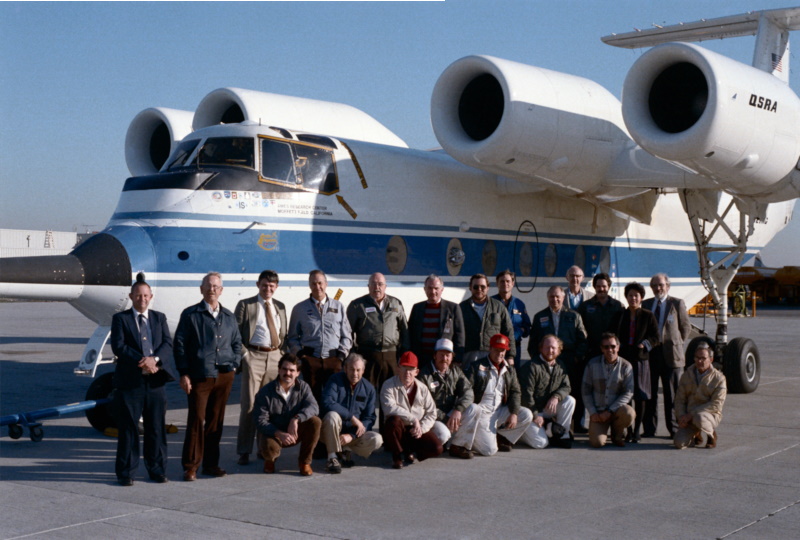
Both the STOL demonstrators were used for further experiments with various advanced flight-control system technology; it seems both were scrapped during the 1980s. Lessons learned were applied to the McDonnell Douglas / Boeing C-17 airlifter program.
* Viking Air of Victoria, British Columbia, has obtained rights to most of the DHC product line, and put the classic DHC-6 Twin Otter back into production, featuring a "glass cockpit" and other improvements. Viking Air has considered restarting production of the Buffalo. Viking officials say that many countries trying to obtain twin-engine cargolifters suffer "sticker shock" when they see the pricetag for new-design machines. Viking officials believe that an updated Buffalo is a much better deal.
The company's proposed "DHC-5NG" would feature a "firewall-forward" transplant of the PW150 turboprop engine, six-bladed composite prop, and nacelle of the Dash-7 Q400 regional airliner, plus a Honeywell Primus Apex flight deck providing a glass cockpit, some composite assemblies, and various other updates. Viking is also considering addition of cockpit pressurization to make the DHC-5NG more competitive with modern cargolifters. However, to date, there's been no action on the matter.
BACK_TO_TOP* I was going to do the Caribou and Buffalo along with the other DHC STOL bushplanes -- Beaver, Otter, Twin Otter -- but the document started to get too complicated, and the two sets of aircraft don't fit so neatly together anyway. I was thinking this document would be too brief, but I found enough to give it some meat.

* Sources include:
There are a number of Caribou-Buffalo websites online. I was able to obtain very detailed lists of aircraft built and their disposition, and for once I have little doubt I got the production quantities right.
* Illustration credits:
* Revision history:
v1.0.0 / 01 jan 12 v1.0.1 / 01 nov 13 / Review & polish. v1.0.2 / 01 oct 15 / Review & polish. v1.0.3 / 01 sep 17 / Review & polish. v1.0.4 / 01 aug 19 / Review & polish. v1.0.5 / 01 jun 21 / Illustrations update. v1.0.6 / 01 may 23 / Review & polish. v1.0.7 / 01 may 25 / Review & polish. (+)BACK_TO_TOP
